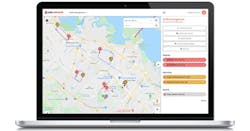The Need for Better Traffic Management During Turbulent Times
There’s no question: road agencies are operating in turbulent times. From the COVID-19 pandemic and the 2020 presidential election to ongoing civil unrest, there have been unprecedented interruptions to the national road network.
The adoption of practical, effective traffic management practices is more critical than ever. Road agencies and transportation departments need to find dynamic solutions to plan, communicate, and analyze traffic data in order to navigate the obstacles present on roadways, highways, and corridors nationwide.
By improving traffic management between agencies, departments, and neighboring jurisdictions, we can surmount the rise in roadway interruptions and keep traffic moving safely. Innovative traffic management platforms designed to maximize visibility of official road data may be the solution to an increasingly complicated road network.
The Impact of COVID-19
The COVID-19 pandemic has had dramatic repercussions on the national roadway. Road agencies and transportation departments are working to navigate lockdown measures, traffic pattern changes, testing stations, designated emergency vehicle routes, and other restrictions.
The need for better traffic management has never been more evident. There is a serious need to limit heavy congestion, manage local traffic pattern strategies for social distancing, and inform the public about detours or roadway changes. Most importantly, road agencies and transportation officials need to find efficient means for emergency vehicles—ambulances in particular—to navigate the streets.
To tackle Covid-related issues, road agencies and transportation departments will need to implement more sustainable, holistic traffic management strategies. Maximizing interdepartmental, interagency, and interstate transparency will be key to maintaining traffic flow within and between major corridors.
That is made harder because alongside limited interstate transportation, quarantine limits, hospital access, and testing stations, organized protests are proving to be one of the biggest obstacles for traffic management experts.
When Michigan Gov. Gretchen Whitmer first extended stay-at-home orders back in April, the Michigan Conservative Coalition organized “Operation Gridlock,” whereby a convoy of motorists flooded Lansing intending to shut down streets in protest. Multiple ambulances were stuck in standstill traffic, and public officials and safety officials struggled to keep traffic flowing.
By improving visibility both between road agencies and with the public, road agencies and transportation departments can help navigate the pandemic’s impact on our regional and national roadways.
Expecting the Unexpected on Election Day 2020
When road officials discuss “turbulent times” in the U.S., something that invariably comes to mind is Election Day 2020.
Nationwide, officials attempted to minimize the inevitable impact. While business owners and property managers boarded up windows in anticipation of protests, law enforcement and transportation agencies implemented road closures in highly populated areas.
Road events around the General Election highlighted a clear need for better communication among drivers, road agencies, and transportation departments. Without a single, accessible source of authoritative traffic data, it was almost impossible for officials to effectively share road information with the public and other stakeholders.
In Los Angeles, for example, officials warned that “street closures and bus detours could go into effect” informally via printed flyer, but could not share any additional information either preemptively or in real-time without the aid of the news media, social platforms, or simple word-of-mouth.
Chicago, New York City, and Philadelphia also shared announcements about potential road closures, but each lacked a critical tool to maintaining safety and security for drivers, road users, and the general public: a clear, real-time vision of traffic conditions from official sources.
In contrast, other states are turning to innovative traffic management platforms to more effectively communicate road information with the public and neighboring jurisdictions. Georgia and Colorado, for example, are both actively involved in pilot programs with one.network, a traffic management solution. Their work zone data is officially live on an interactive map accessible to drivers, public officials, law enforcement, and other stakeholders.
Civil Unrest: Managing Protests & Demonstrations
In addition to the frenzy surrounding the 2020 Election, the U.S. is experiencing a historic wave of civil unrest. Protests and other demonstrations are breaking out nationwide, most prominently in protest of systemic racism following the deaths of George Floyd, Breonna Taylor, and Ahmaud Arbery.
For road agencies and transportation departments, effective road management is critical to keeping protesters, drivers, and the public safe. With over 100 protesters hit by cars during protests this year alone, prioritizing more effective communication and coordination around public protests and civil demonstrations has become the highest priority.
To that end, the Bureau of Justice Assistance published a guide for local law enforcement agencies to aid in protests, demonstrations, and other planned civil events. Managing Large-Scale Security Events: A Planning Primer for Local Law Enforcement Agencies provides specific guidance for minimizing traffic impact while maximizing public safety.
A large number of the guidelines detail a need for effective communication, coordination, and collaboration both between agencies and with the general public. Here are some of the most critical points:
- Conducting a needs assessments: Combine real-time traffic data and planned upcoming closures to ensure proper manpower
- Pre-designating parade & march routes: Controlling demonstrator activities to better manage traffic interruptions of planned demonstrations
- Establishing emergency vehicle protocols & routes: Collecting and communicating fire and EMS transportation protocols and traffic routes to the public and other agencies
- Developing operational plans for public affairs: Sharing traffic plans, road closures, security screening protocols, and prohibited items with the public
- Creating event maps: Law enforcement and city partners must be ready to create maps to track incidents, traffic, and other information important to the media and the public.
The First Amendment clearly outlines “the right of the people peaceably to assemble,” and as such, road agencies, transportation authorities, and public officials need to ensure they are accommodating those rights while maintaining the highest level of safety for the public.
Conclusion
As a nation, we are experiencing significant turbulence. But that makes the responsibility of those in authority all the more pressing: as traffic management experts, it is vital that we identify the impact of traffic interruptions early and often while maintaining clear visibility between departments, agencies, and the public.
Traffic management technologies are becoming increasingly popular among road agencies and transportation departments to help navigate increasingly turbulent times. We need to find innovative solutions for collecting, coordinating, and communicating road event data in order to overcome the most pressing challenges present on the road network today.
With more effective traffic management practices that foster better visibility and collaboration both between agencies and with the public, we can work to minimize the impact of traffic interruptions on the road network to keep our country moving forward—both literally and figuratively.

